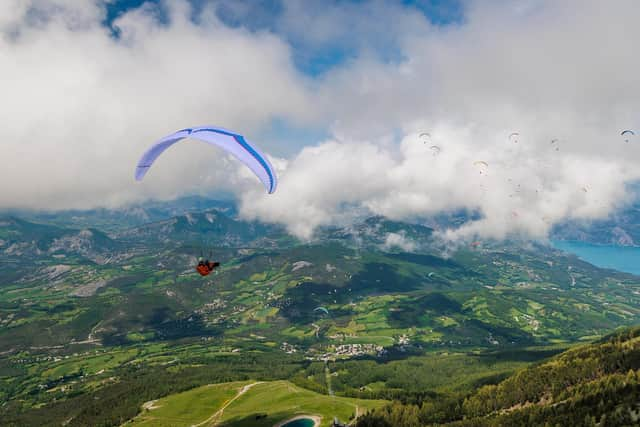Book review: Head in the Clouds, edited by Andrew Craig and Hugh Miller
"My heart is pounding, I can feel my blood racing through my veins. Trying to keep steady, I suck in my stomach, take a deep breath, it's now or never... Ready, set, go! Run, run! I feel the wind lift the kite, and my feet are off the ground. Wow! Fantastic! I'm flying through the air!"
So wrote hang glider pilot Kaz de Lisse back in 1973, in his ecstatic account of his first ever flight. A former US Marine who had fought in the brutal battle for Iwo Jima during the Second World War, de Lisse went on to become flight director of the Southern California Hang Gliding Association, the forerunner of the US Hang Gliding & Paragliding Association. That organisation now has some 8,000 members, but back in the 1970s the sport was still so niche that, in many parts of the world, when a pilot landed in the middle of the countryside they would quickly be mobbed by curious locals, eager to find out how it was possible to take to the sky and fly around without any kind of propulsion.
Advertisement
Hide AdAdvertisement
Hide AdDe Lisse's account is just one of 50 featured in a new book titled Head in the Clouds: The Best Stories From 50 Years of Free Flying, edited by two veteran free flight journalists, Scot Andrew Craig and Englishman Hugh Miller. Many of the stories are taken from UK-based free flight journal Cross Country magazine, but the book also includes articles from earlier publications.


Hang gliding was by no means new when de Lisse took his first flight in '73 – the German pioneer Otto Lilienthal was making regular controlled glider flights back in the 1890s – but in the 1960s and 70s the sport enjoyed a major renaissance after a NASA engineer, Francis Rogallo, developed a self-inflating wing intended to help spacecraft glide safely back to earth after re-entering the atmosphere. As with other adventure sports like surfing, which were exploding in popularity at around the same time, the heady post-war mixture of increased leisure time, greater expendable income and rapid advances in technology allowed hang gliding to blossom.
Some of the more intoxicating accounts in Head in the Clouds come from these early days, when the sport must still have seemed almost like a secret club, accessible only to those in the know and incomprehensible to everyone else. In an article titled "Kilimanjaro, 1978", for example, Ashley Doubtfire describes an otherworldly flight from the summit of the titular mountain, dodging towering cumulus clouds and unexpected turbulence. On landing, he writes, he found himself "totally surrounded by inquisitive and unbelieving faces." Among them was a policeman, who asked him for his papers. Doubtfire explained that he had none, so the policeman asked him where he had come from. "From the top of Kilimanjaro," he replied. "In that case," said the policeman, "perhaps you may be excused."
Many of the stories follow an arc that will be familiar to practitioners of other adventure sports. There's the identification of a goal; the preparation; the journey to the start of the challenge; the "peak moment"; then the aftermath. Regular readers of skiing or surfing magazines might not know the first thing about thermals, but they will instantly recognise the narrative structure of the majority of these tales, and the thirst for adventure that drives the protagonists. This commonality is all-but spelled out in "The Ballad of Robb and Joe" – a tale of hang gliding misadventure by the veteran Californian surf journalist Matt George. Looking back to a windy day in 1971, George remembers how he and his brother Sam – aged just 12 and 15 at the time – hitched a ride to the beach at Fort Funston, San Francisco, with some older kids from school and witnessed "a group of hippies wrestling with what looked like a plastic-wrapped wooden Christmas Tree." They soon realised that the hippies were in fact trying to launch a hang glider, and – as surfers – "to our eye and to our hearts, the machine and the mission made perfect sense." When the hippies failed to get airborne as they were all too heavy, Matt volunteered, but his protective big brother took his place, eventually achieving a flight of nine seconds, but then getting "banged up" in a crash. Still, at least there were "handshakes all round" and it turned out that the hippies were in fact postgrad students from Berkeley "developing a manned Rogallo wing for some big engineering design competition."
As with other adventure sports, the world of free flight is full of near-misses, and there are some white-knuckle rides here. Particularly terrifying is "The Croatian Survivor", Davor Jardas's tale of getting sucked into a thunder cloud and nearly freezing to death. It ends with a common refrain: that taking risks can make you feel more alive. After Jardas and several other pilots cheated death that day, they all met up at a restaurant called Fortuna – as Jardas puts it, “to celebrate our new life.”
Head in the Clouds, edited by Andrew Craig and Hugh Miller, Cross Country, £28
